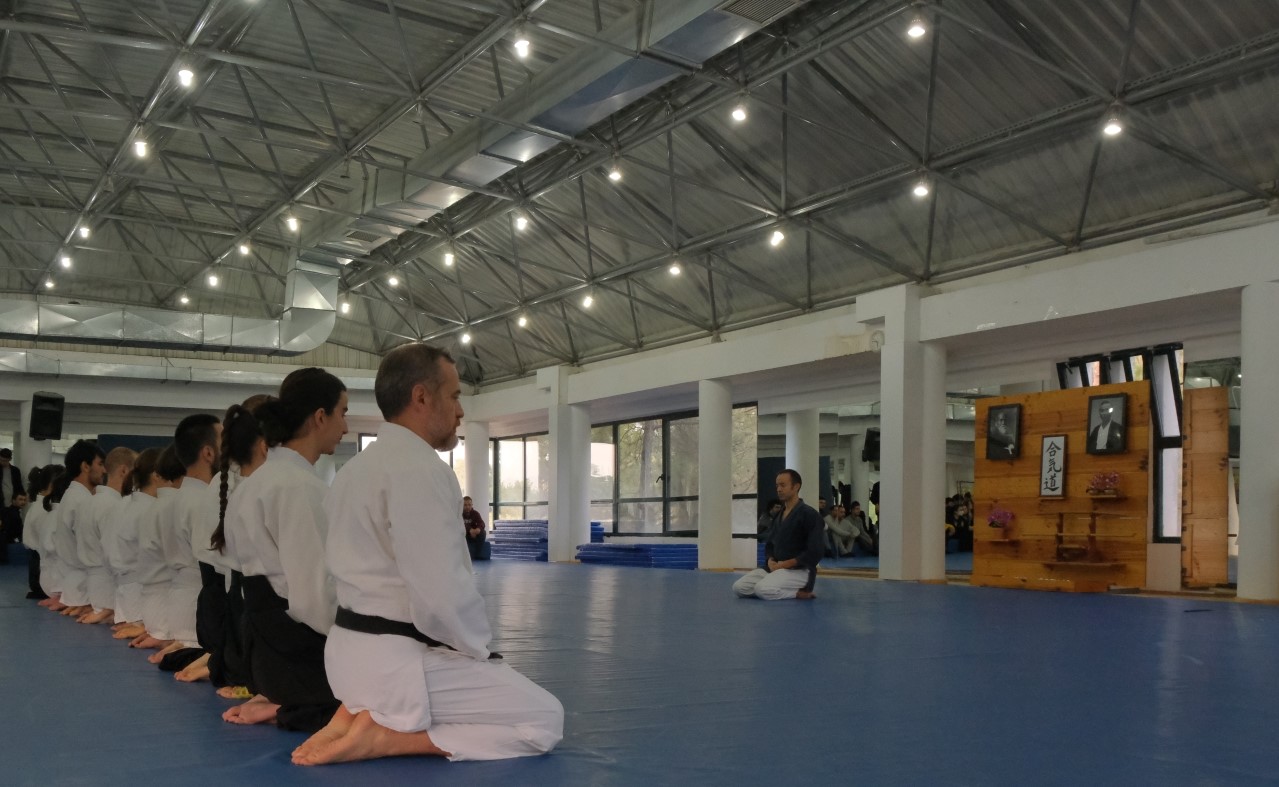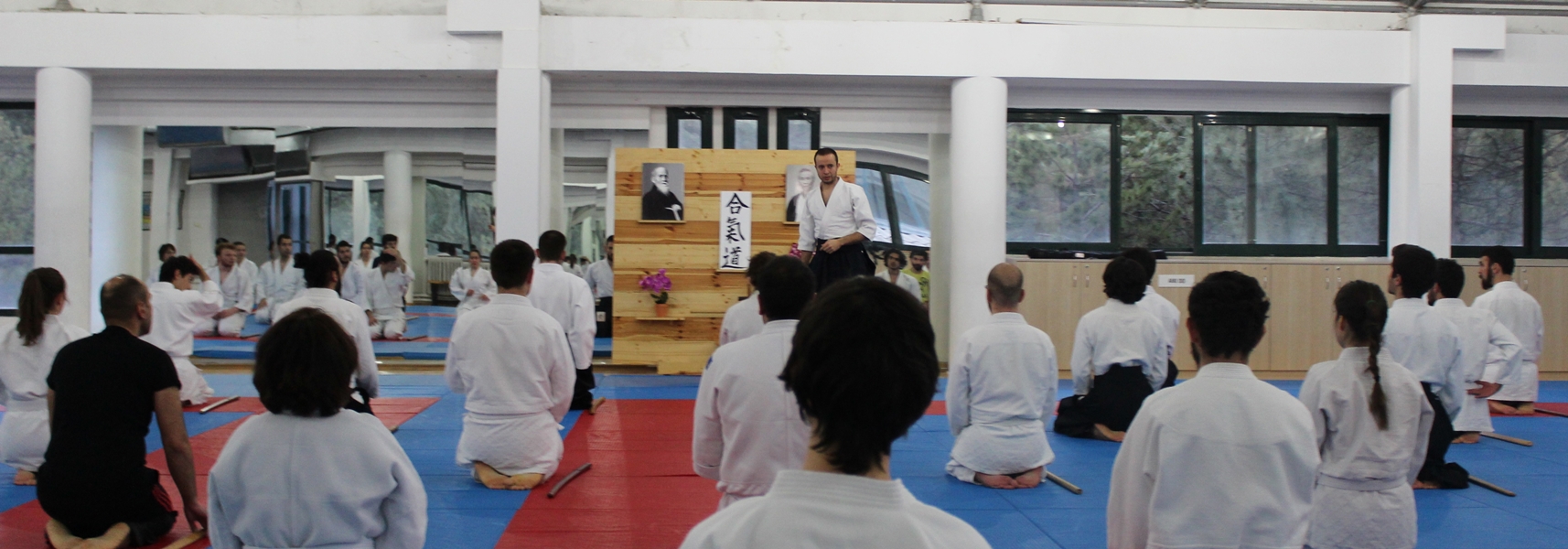History of Aikido
 Nowadays, the word aikido is well-known throughout the world. The founder of this budo art was Ueshiba Morihei (1883-1969). Born in what is now modern day Wakayama Prefecture, Morihei commenced studying a number of different martial art systems from 1897. According to surviving records, he learned various jujutsu styles including Kito-ryu , Goto-ha Yagyu-ryu , and Daito-ryu. In the course of his studies, he began to doubt the prevalent ideals which espoused winning by killing. This dissatisfaction provided the impetus for Morihei to establish aikido. In November 1919, when Morihei was working in the Hokkaido developmental projects, he received a telegram informing him of his father’s poor health. He left Hokkaido, and while riding the train back to his hometown, he overheard a conversation about a person with miraculous powers to heal the sick. That person was Deguchi Onisaburo (1871-1948), leader of the O moto-kyo religious movement.
Nowadays, the word aikido is well-known throughout the world. The founder of this budo art was Ueshiba Morihei (1883-1969). Born in what is now modern day Wakayama Prefecture, Morihei commenced studying a number of different martial art systems from 1897. According to surviving records, he learned various jujutsu styles including Kito-ryu , Goto-ha Yagyu-ryu , and Daito-ryu. In the course of his studies, he began to doubt the prevalent ideals which espoused winning by killing. This dissatisfaction provided the impetus for Morihei to establish aikido. In November 1919, when Morihei was working in the Hokkaido developmental projects, he received a telegram informing him of his father’s poor health. He left Hokkaido, and while riding the train back to his hometown, he overheard a conversation about a person with miraculous powers to heal the sick. That person was Deguchi Onisaburo (1871-1948), leader of the O moto-kyo religious movement.
Morihei thought he may be able to help his ailing father. He diverted his journey to Ayabe in Kyoto Prefecture to solicit Onisaburo’s help. The meeting with Deguchi Onisaburo was fateful and served to intensify Morihei’s fascination with spiritualism. The following year in 1920, Morihei moved to Ayabe and established a dojo there. From 1922, he called his style of martial an “aiki-bujutsu”.
One day in 1925, Morihei experienced an epiphany which was to change his life. He realized that when everything is shrouded in love and flows with natural energy or ki, then the self and others can all merge in mind, spirit, and body. This realization became the basis of his philosophy vis-a-vis more violent and confrontational martial arts.
Following an invitation by Admiral Takeshita lsamu in 1927, Morihei moved to Tokyo. From that time, Tokyo became the base for his activities to promote his martial art. In 1931, he built the Kobukan dojo in Shinjuku’s Wakamatsu district. His organization was granted permission by the Ministry of Health to collect financial donations from 1940, signifying governmental auth oriza tion and acceptance of his activities. His early students (military men, aristocrats, businessmen, etc.) were all introduced privately. He accepted requests for instruction from special interest groups but did not initially offer lessons to the general public. Morihei was concerned that if his aiki-bujutsu was taught to the masses, the techniques might be used indiscriminately for nefarious purposes.
He probably changed the name of his art to aikido in 1942. Until then, a number of appellations were in use such as aiki-jujutsu, Ueshiba-jujutsu, aiki-budo, and aiki-bujutsu. This change came about when he affiliated with the Dai-Nippon Butokukai, the umbrella organization for martial .arts in Japan at the time. In the same year, Morihei’s son, Ueshiba Kisshomaru, was appointed as president of the Kobukai Hombu Dojo (headquarter dojo of the organization). Kisshomaru was entrusted with all administrative tasks affording Morihei more freedom to promote Aikido. In 1947, the Kobukai was reorganized, and its name was changed to the Aikikai.
Aikido was widely promoted among the general public in the postwar period, but up to that time, few people had seen or even heard of aikido before. To increase its presence in the wider community, the Hombu Doj6 decided to dispatch instructors to universities with the intention of forming clubs. From around 1955, the Aikikai conducted a
number of small demonstrations and lectures in an effort to increase membership.
The Aikikai held its first major Aikido Embu Taikai (demonstration) in May 1960, in Tokyo, where 180 practitioners demonstrated aikido techniques to a packed hall of 1,600 interested onlookers. This demonstration served to raise the profile of aikido which was still relatively unknown. The Embu Taikai has continued as an annual event and now there are over 7,500 participants each year. It is now held in the Nippon Budokan’s main dojo in order to accommodate the large number of people.
As an auxiliary body of the Aikikai Foundation, the National Student Aikido Federation was established in 1961. In December the same year, the Ministry of Defence Aikido Union was inaugurated to promote aikido nationally through the Self-Defence Forces. Due to the rapidly increasing membership, a new three-story Hombu Dojo was
constructed in Tokyo in 1968 with another two floors added in 1973. Apart from regular training sessions, the building houses the Aikido Gakko which teaches the educational principles of aikido. The Aikido Gakko, the only aikido school officially recognized by the Tokyo Metropolitan Government, offers an advanced course separate
to the regular and beginner programs.

Just as aikido was entering an age of popularity, Ueshiba Morihei passed away on April 26, 1969, at 86 years of age. His son, Kisshomaru, became the second Doshu, the highest post in aikido.
Aikido continued to expand after Morihei died. The All Japan Aikido Federation was established as an auxiliary organization to the Aikikai in May 1976. The International Aikido Federation (IAF) was also founded in the same year, with the first general assembly co nducted in October. In 1986, Kisshomaru’s son, Moriteru, was appointed as director general of the Hombu Dojo and was made the chairman of the Aikikai Foundation in 1996. Kisshomaru died on January 4, 1999, and Moriteru became the third Doshu.
TI1e oldest existent aikido dojo created by the founder, the Aikikai Foundation’s H ombu Dojo, is the uppermost technical and philosophical authority for the art and serves as the umbrella o organization n under which regional branches and auxiliary groups are positioned. The Hombu Doj6 administers national training seminars, promotion
examinations, and also publishes literature pertaining to aikido.
Efforts to popularize aikido overseas began in 1952 when instructors were dispatched to France and the United States. From around 1960, a number of young instructors from the Hombu Dojo was sent to instruct in many more countries including Britain, Italy, Germany, and Australia. ln 2007, a milestone was reached when the fiftieth official group of instructors from the Hombu Dojo was dispatched overseas.
Currently, aikido is practiced in over ninety countries around the world, and domestic branches of the Aikikai also have affiliated clubs overseas. Most of the initial promotional efforts were centered in the United States. However, in the last decade or so, other countries and regions have also seen a considerable rise in interest. For example, when
Moriteru Doshu visited South America in 2006, over two-thousand people attended the program conducted in Brazil and eight-hundred in Argentina.
Apart from instructional activities promoted by the Hombu Dojo, the Japanese government also supports the international propagation of aikido. ll1e Japan International Cooperation Agency (JICA) is a special public corporation established to promote international assistance. Through the provision of overseas development
support, young or senior Japanese citizens go overseas on volunteer missions. In 1980, two people participated in the JICA program in Papua New Guinea where they taught aikido. Until now (2009), thirty-eight instructors have been sent to thirteen countries in the regular program, and fifteen people to six countries on the senior program starting with Laos in 2001.
Source: Nippon Budokan (2009) BUDO, The Martial Ways of Japan, Japan.





